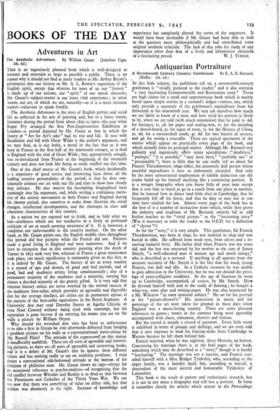Adventures in Art
The Aesthetic Adventure. By William Gaunt. (Jonathan Cape. 10s. 6d.)
Tars is an ingeniously planned book which is well-designed to instruct and entertain as large as possible a public. There is no reason why it should not find as many readers as Mr. Arthur Bryanes adventures into our history or Mr. A. L. Rowse's exposition of the English spirit, except that whereas for most of us our " history " is made up of our actions, our "spirit" of our moral character, Mr. Gaunes subject-matter is our inner vital experience ; in other words, our art, of which we are, naturally—as it is a more intimate matter—reluctant to speak frankly.
The Aesthetic Adventure is the story of English private and social life as reflected in the arts of painting and, but to a lesser extent, literature during the period from about I85o to I910—the year when Roger Fry arranged the first Post-Impressionist Exhibition in London—a period depicted by -Mr. Gaunt as that in which the theory of "Art for Art's sake" had its rise and fall. It rose with Baudelaire and fell with Oscar Wilde is the author's argument, and we may find, as is our habit, a moral in the fact that as it was born in France in the first half of the nineteenth century, so it died in England with the trial of Oscar Wilde ; but, appropriately enough, was re-introduced from France at the beginning of the twentieth century and does not look like being so easily snuffed out this time.
One of the chief merits of Mr. Gaunt's book, which incidentally is a repository of 'good stories and interesting facts about all the leading creative personalities of the period, is that he does continuously connect our art with our life and tries to show how closely they interact. He also weaves his fascinating biographical facts cunningly into his argument, and, while writing a continuous narrative of the artistic movements in both France and England during his chosen period, also contrives to make them illustrate the social changes, intellectual developments, and the cleavages in class and education characteristic of this country.
As a nation we are reputed not to think, and to hide what we feel—attributes which are not conducive to a lively or profound criticism of art or much seeming awareness of it. It is, however, a condition not unfavourable to the creative instinct. On the other hand, as Mr. Gaunt points out, the English middle class throughout this period did buy pictures while the French did not. Painters made a good living in England and were numerous. And if we have to recognise that in this country painting after the death of Turner in 1851 sank very low, whereas in France a great renaissance took place, too much significance is commonly given to this fact, as it is indeed by Mr. Gaunt. The history of art in every country is a record of ups and downs, of good and bad periods, and of good, bad and mediocre artists living simultaneously ; also of a permanent majority of the mediocre and a minority, varying but always a decided minority of the greatly gifted. It is very odd that whereas literary critics are never worried by the eternal success of the mediocre best-seller, which provides an agreeable and digestible diet for the average intellect, art critics are in permanent uproar at the success of the best-seller equivalents in the Royal Academy. A University don may read Dorothy Sayers or Agatha Christie or even Noel Coward without being eyed with contempt, but his reputation is gone forever if on entering his rooms you see on the walls a picture by William Orpen. Why should the wretched don who has been so unfortunate as to take a first in Greats be ever afterwards debarred from hanging a problem picture on his walls or a representational water-colour by Mr. Russell Flint? The attitude of the cognoscenti on this matter is insufferably snobbish. There are all sorts of agreeable and interesting pictures, as there are all sorts of agreeable and interesting books, and it is a defect of Mr. Gaunes that he ignores these different values and has nothing really to say on aesthetic problems. I even detect a conventional old-fashioned attitude at the bottom of his criticism of philistine taste. Mr. Gaunt shows no sign—except for an occasional reference to psycho-analysis—of recognising that the old conflict between Whistler and Ruskin is as dead as that between the Protestants and Catholics of the Thirty Years War. We can see now that there was something of value on either side, but that neither was absolutely in the right. Increase of knowledge and
experience has completely altered the terms of the argument. It would have been invaluable if Mr. Gaunt had been able to look at the question more philosophically and had contributed some original aesthetic criticism. The lack of this robs his study of any importance other than that of a lively and informative chronicle of a fascinating period. W. J. TURNER.






















 Previous page
Previous page